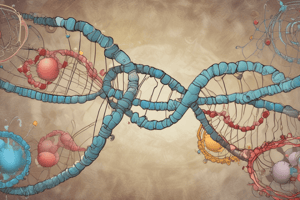Podcast
Questions and Answers
What are the two types of nitrogenous bases?
What are the two types of nitrogenous bases?
- Purines and Pyrimidines (correct)
- Amino Acids and Proteins
- Adenine and Uracil
- Cytosine and Thymine
Which sugar is found in RNA?
Which sugar is found in RNA?
- Deoxyribose
- Ribose (correct)
- Sucrose
- Glucose
What type of structure does DNA have?
What type of structure does DNA have?
- Circular
- Double stranded (correct)
- Single stranded
- Triple helix
Which nitrogenous base is exclusive to RNA?
Which nitrogenous base is exclusive to RNA?
What is the main function of DNA?
What is the main function of DNA?
Where is DNA primarily located within the cell?
Where is DNA primarily located within the cell?
How many types of RNA are there?
How many types of RNA are there?
What links the phosphate group of one nucleotide to the hydroxyl group of the next nucleotide?
What links the phosphate group of one nucleotide to the hydroxyl group of the next nucleotide?
Which is longer, DNA or RNA?
Which is longer, DNA or RNA?
Which of the following is a pyrimidine base?
Which of the following is a pyrimidine base?
Flashcards are hidden until you start studying
Study Notes
Properties of Water and Soil Formation
- Water expands when frozen, aiding in rock fragmentation.
- Contributes significantly to soil creation.
- Absence of soil leads to barren land, unfit for plant life.
- Lack of plants results in hostile environments for animals and other organisms.
Carbohydrates: Overview
- Organic compounds consisting of carbon, hydrogen, and oxygen in a 1:2:1 ratio.
- General formula: (CH2O)n.
- Types of carbohydrates: small and soluble (monosaccharides) or long chains (polysaccharides such as starch and cellulose).
Functions of Carbohydrates
- Primary energy source.
- Energy storage and food reserve.
- Structural role in cells (e.g., cell walls).
- Essential component of nucleic acids.
- Provides defense and protection mechanisms.
Monosaccharides
- Simple sugars characterized by simple structures.
- Classified by carbon count:
- Triose (C3H6O3)
- Pentose (C5H10O5)
- Hexose (C6H12O6)
- Common hexose sugars include:
- Glucose (blood sugar)
- Galactose (milk sugar)
- Fructose (fruit sugar)
- Characteristics: sweet, water-soluble, reducing sugars, crystallizable, low molecular mass.
Disaccharides
- Formed from two linked monosaccharides through condensation.
- General formula: C12H22O11.
- Characteristics: sweet, water-soluble, crystallizable, mostly non-reducing sugars, can be hydrolyzed into monosaccharides.
- Common disaccharides:
- Maltose: Glucose + Glucose; reducing sugar, hydrolyzed by maltase.
- Sucrose: Glucose + Fructose; non-reducing sugar, hydrolyzed by sucrase.
- Lactose: Glucose + Galactose; reducing sugar, hydrolyzed by lactase.
Polysaccharides
- Long chains of monosaccharides bonded via glycosidic bonds; formula: (C6H10O5)n.
- Serve as energy storage (e.g., starch) and structural components (e.g., cellulose).
Lipids Characteristics
- Composed mainly of fatty acids and glycerol, non-polar (hydrophobic), and soluble in organic solvents.
- Do not dissolve in water and are resistant to oxidation compared to carbohydrates.
- Major types include triglycerides (fats and oils), waxes, phospholipids, and steroids.
Triglycerides
- Formed by three fatty acids and one glycerol through condensation reactions.
- Solid state: fats; liquid state: oils.
- Fatty acids can be saturated or unsaturated.
Phospholipids and Steroids
- Phospholipids consist of a glycerol molecule, two fatty acids, and a phosphate group, vital for biological membranes.
- Steroids have a structure based on a 17-carbon skeleton, involved in bioactivity (e.g., hormones).
Protein Classification
- Proteins consist of amino acids linked by peptide bonds; classified as:
- Simple proteins: contain only amino acids.
- Fibrous proteins: long, insoluble chains; provide structural support.
- Globular proteins: tightly folded, soluble in water; metabolically active.
- Conjugated proteins: contain amino acids and non-protein components.
Nucleic Acids
- Formed by linking nucleotides, which consist of a phosphate group, sugar, and nitrogenous base.
- DNA:
- Sugar: deoxyribose.
- Contains adenine, thymine, cytosine, guanine.
- Double-stranded, helix structure, carries genetic information, primarily in the nucleus.
- RNA:
- Sugar: ribose.
- Contains adenine, uracil, cytosine, guanine.
- Single-stranded, crucial for protein synthesis, located in nucleus and cytoplasm.
Nitrogenous Bases
- Two categories:
- Purines: Adenine, Guanine.
- Pyrimidines: Cytosine, Thymine (in DNA), Uracil (in RNA).
Studying That Suits You
Use AI to generate personalized quizzes and flashcards to suit your learning preferences.




